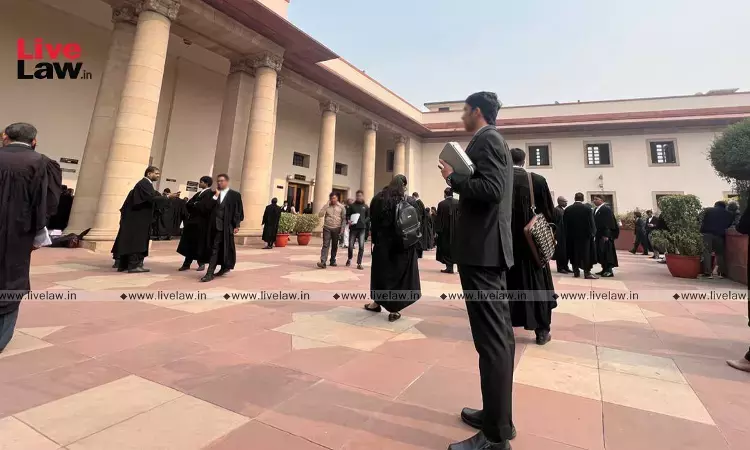'Community Service' Under The BNS – An Incomplete Yet Promising Penologocial Advancement

The BNS, 2023, has for the first time introduced 'Community Service' as an alternate to imprisonment[1]. This welcome step marks a significant shift in the sphere of penology under the Indian criminal justice system.Punishments seek to serve various objectives, some of which are retribution, justice, deterrence, reformation etc. Modern sentencing policies reflect a combination of several or...
The BNS, 2023, has for the first time introduced 'Community Service' as an alternate to imprisonment[1]. This welcome step marks a significant shift in the sphere of penology under the Indian criminal justice system.
Punishments seek to serve various objectives, some of which are retribution, justice, deterrence, reformation etc. Modern sentencing policies reflect a combination of several or all of these aims[2]. In 106 BC, Cicero wrote “Let the punishment fit the crime”. To this day, this phrase remains a core criminal justice principle in legal frameworks across the globe.
Criminologists believe that one of the early examples of the idea that the objective of punishment is reformation of convicts, can be traced back to the 16th century when King Edward VI- in order to deal with vagabonds, established the 'House of Correction of Bridewell Palace' in London[3]. The House of Bridewell was run on an interesting underlying philosophy- that reformation of the offender could be obtained through learning trade. In the modern day this philosophy serves as a model for ideal prisons.
In 1970, in England, Barbara Wootton- a famous English social scientist, wrote a report titled 'Non-custodial and Semi-custodial Penalties'. This report recommended “community service” as an alternative to imprisonment. Later, these recommendations led to the enactment of 'The Criminal Justice Act of 1972' in the UK, which is now 'The Powers of Criminal Courts Act, 1973.' This Act lays down the guidelines for passing and enforcing the community service orders in the UK.
In America, formal Community Service programs began in 1966 with the establishment of the Alameda County California program. Judges of the municipal court would sentence traffic offenders to unpaid labour or community service and a special agency was established to administer such punishments. Since then, 'community service' has been used widely in America to punish petty offences, for example in cases of vandalism, petty theft, shop lifting, drunk driving etc. Several other jurisdictions and countries in Europe, Africa and Middle East have also adopted community service as an alternate to imprisonment.
In spite of its success in other jurisdictions, and almost a half century after its introduction in UK in 1973, India has for the first time introduced community service as an alternate to prison sentencing under the new BNS, 2023. It is pertinent to note that in 1997, the 156th Law Commission Report had recommended for an amendment to Section 53 IPC to include 'community service' as an alternate to prison sentence, however, this recommendation was never adopted.
Previously, in the absence of any statutory prescription in the IPC and CrPC, a few High Courts have passed directions for the accused to perform community service. The Bombay High Court has directed the accused to render community service at BARC Hospital[4], in a petition for quashing of FIR for offences under sections 385 and 451 read with 34 of the Penal Code after compromise between the parties; In another case, after settlement was reached between the parties, The Bombay High Court[5] directed the accused to perform community service at a Hospital as a condition for quashing an FIR u/s 354/506/342 IPC; In Sunita Gandharva v State of MP[6], the issue before the MP High Court was whether the scope of bail condition u/s 437(3) CrPC was wide enough to include community service. The High Court answered the question in the affirmative and held that the phrase “any other conditions in the interest of justice” laid down in Section 437(3) of CrPC gave the power to the Court to direct the accused/ offender to perform community service or other connected reformatory measures. It was held that these conditions could also be “Innovated”, however, such conditions must be voluntarily offered by the accused and the Court should take into consideration the capacity and willingness of offenders/accused; In Giljar Singh v State of Madhya Pradesh[7], the High court of Madhya Pradesh, granted regular bail u/s 188 IPC on the condition of installing Water Harvesting System or Water Recharge System. In Banti Jadhav[8], a condition of serving at the primary health center was impose while granting regular bail under the MP Excise Act; A direction to plant saplings was imposed while granting regular bail u/s 307 IPC in Shiv Kumar vs State of MP[9].
The Supreme Court, however, often interfered when 'freakish' conditions were imposed by High Courts. In Aparna Bhat Vs. State of MP (Criminal Appeal 329 of 2021), while setting aside the condition to 'tie a rakhi' while granting bail to an accused of sexual harassment the court held that: “imposing conditions that implicitly tend to condone or diminish the harm caused by the accused and have the effect of potentially exposing the survivor to secondary trauma, such as mandating mediation processes in non-compoundable offences, mandating as part of bail conditions, community service (in a manner of speaking with the so-called reformative approach towards the perpetrator of sexual offence) or requiring tendering of apology once or repeatedly, or in any manner getting or being in touch with the survivor, is especially forbidden.” The Apex Court, relied on its earlier decision in Munish Bhasin[10], where it had held that Courts cannot impose 'freakish conditions' and conditions that can be imposed are enumerated u/s 438(2) and to subject an accused to any other condition would be beyond jurisdiction of the power conferred on Court under section 438 of the Code.
Community service as an alternate to imprisonment serves several purposes. From a state-resource-perspective it immediately prevents further burdening our already overcrowded prison. The most recent data of the overcrowding of prisons in India is available from the year 2021. The inmate population in 1319 jails in the country grew by 13%, from 4.8 lakh in 2020 to 5.5 lakh in 2021, taking the national average overcrowding to 130 percent[11]. Guided by the reformative theory of punishment and to check the overcrowding of prisons in India, the BNS has introduced community service in addition to imprisonment or fine as a form of punishment for the following 6 offences: (a) Section 202: Public servant unlawfully engaging in trade[12]; (b) Section 209: Nonappearance in response to a proclamation under section 84 of BNSS, 2023[13]; (c) Section 226: Attempt to commit suicide to compel or restrain exercise of lawful power; (d) Section 303(2) proviso: Theft where the value of the stolen property is less than 5,000 rupee and a person is convicted for the first time and returns or restores the value of property[14]; (e) Section 355: Misconduct in public by a drunken person[15]. (f) Section 356 (2): Defamation[16].
The BNS has introduced 'community service' as a form of post-conviction punishment. It is a beneficial provision and its introduction is a welcome step from a criminal justice standpoint. It is noteworthy that community service is not available as a bail condition.
The benefits of Community service are limited not only to sending fewer persons to prison and in reducing prison overcrowdings. From a convict's standpoint, community service will reduce the exposure of a petty criminal or a first time offender to more hardened and habitual inmates, giving them a real chance at reformation. In 1771, John Howard, in his book 'The State of the Prisons in England and Wales' wrote that “Prisons are the schools for crime”. This new form of alternate sentencing would prove effective in the protection and reformation of convicts.
Despite the benefits of community service, we mustn't forget that there have been longstanding concerns regarding the absence of sentencing guidelines in our legal system. These concerns are bound to be heightened with the addition of a new, all-encompassing sentencing format like 'community service', especially with the statute not laying down any guidance for its imposition or implementation. The absence of any legislative guidance is bound to make the sentencing pendulum swing.
The Parliament had a clean slate with the replacement of the IPC and the introduction of the BNS. While community service has been added to the rule book, the statute is vague and bereft of details. Even a passing glance would reveal that the statute is silent on the definition of what would constitute “Community Service.” No framework has been provided for its enforcement. Not only should general guidelines for community service be laid down the law should, inter-alia, define community service, hours of community service, default sentencing/fine, implications of breach of community service orders, mechanism for implementing, supervising and overseeing the community service program etc.
The statute should be suitably amended to empower the trial courts with the discretion to select a suitable community service program that in its wisdom would best suit the convict and the conviction, thus, shifting the spotlight to conscious and responsible penology. The range of community service work will have to be defined and ring fenced. It could include working in the social service arena such as services at hospitals or rehabilitation centres, or require performance of manual or non-manual work, or may require serving nonprofit organizations for social services, or require assisting in government awareness programs etc.
Community service, with all its benefits, can also be considered as an alternative to punishment (sentencing/ fine) for those offences under the BNS which prescribe shorter sentences. The following offences under the BNSS could include community service as an alternative to punishment: S.346 Removing, destroying or defacing property mark with the intent to cause injury (Prescribed punishment as per BNS- Imprisonment for 1 year or fine or both); S.329(4) House trespass (Prescribed punishment as per BNS- Imprisonment for 1 year, or fine of 5,000 rupees, or both); S.324(2) Mischief (Prescribed punishment as per BNS- Imprisonment for 6 months, or fine , or both); S.326(e ) Mischief by destroying or moving etc., a landmark fixed by public authority (Prescribed punishment as per BNS, Imprisonment for 1 year or fine , or both); S. 296 Obscene acts and songs (Prescribed punishment as per BNS- Imprisonment for 3 months, or fine of 1000 rupees, or both) ;S.297(1) Keeping a lottery office (Prescribed punishment as per BNS- Imprisonment for 6 months, or fine, or both); S.297(2) Publishing proposals relating to lotteries ( Prescribed punishment as per BNSS – fine of Rs. 5,000); S.285 Causing danger or obstruction in public way or line of navigation (Prescribed punishment as per BNS-fine of Rs.5000); S.291 Negligent conduct with respect to animal (Prescribed punishment as per BNS- Imprisonment for 6 months, or fine of Rs.5,000 rupees , or both); S.221 Obstructing public servant in discharge of his public functions (Prescribed punishment as per BNS- Imprisonment for 3 months, or fine of Rs.2,500 rupees, or both); S.194(2) Committing affray (Prescribed punishment as per BNS- Imprisonment for one month, or fine of 1,000 Rs., or both); S. 186- Fictitious stamps (Prescribed punishment as per BNS fine of Rs. 200 Rs); S.122(1)- Voluntarily causing hurt on grave and sudden provocation not intending to hurt any other than the person who gave the provocation (Prescribed punishment as per BNS Imprisonment for 1 month, or fine of Rs.5,000 rupees, or both).
It may be beneficial if community service were to be introduced in some other statutes for offences which carry short sentences. For example, under the Motor Vehicle Act,1988 (for minor offences like driving without licenses[17], drunken driving[18], driving dangerously[19]) and under the NDPS Act (for drug consumption u/s 27 NDPS Act). The Probation of Offenders Act (S.3,4,5,6) may suitably be amended to include terms for community service.
In summation, while the introduction of community service under the new penal code is a welcome step, the statute has a long way to go before the full potential of this beneficial provision could be harnessed. The parliament and executive should do better than miss this opportunity.
Author is an AOR and practices law before the Supreme Court.
Views Are Personal
References:
The first statutory reference for “community service” in India, is found in S. 18 (1)(c) of the Juvenile Justice Act, 2015. However, there was no provision for community service under the general penal law till the BNS, 2023. ↑
Shatrughan Chauhan (2014) 3 SCC 1 ↑
(Leonard A Roberts- Bridewell: The Worlds First Attempt at Prisoner Rehabilitation Through Education Vol 35 Issue 3, Journal of Correctional Education) ↑
2015 SCC OnLine Bom 7171 ↑
WP (Crl) 116/2022 ↑
2020 SCC OnLine MP 2193 ↑
M.Cr.C. No.29827/2019 ↑
MCRC-28687-2020 ↑
2005(3) MPHT 466 ↑
(2009) 4 SCC 45 ↑
India Justice Report 2022 ↑
S.168 IPC 1860 ↑
S.174A IPC ↑
S.379 IPC. No categorization of offences on the value of the stolen property ↑
S.510 IPC ↑
S.500 IPC ↑
Section 182, MV Act, 1988 ↑
Section 185, MV Act, 1988 ↑
Section 184, MV Act, 1988 ↑




